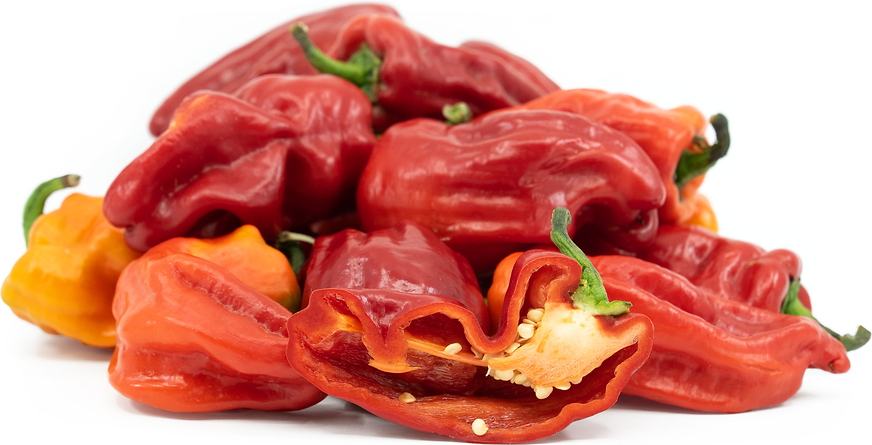


Aleppo Chile Peppers
Estimated Inventory, 5 lbs : 0
Description/Taste
Aleppo chile peppers are conical, straight to curved pods, averaging 5 to 10 centimeters in length, and feature deep, vertical indentations across the surface. The skin of the pod is glossy, smooth, and firm with a waxy consistency, transitioning in color from green, orange, to bright red when mature. Underneath the surface, the semi-thick flesh ranges from pale red to orange and is crisp, striated, and aqueous, encasing a central cavity filled with membranes and small, round, cream-colored seeds. Aleppo chile peppers have a tangy, earthy, and semi-sweet flavor, prominently followed by fruity undertones and a slow-building, moderate to pungent heat.
Seasons/Availability
Aleppo chile peppers are available in the late summer through early fall.
Current Facts
Aleppo chile peppers, botanically classified as Capsicum annuum, are spicy, brightly colored pods that grow on shrubs reaching up to one meter in height and are members of the Solanaceae or nightshade family. Named after one of the oldest cities in northern Syria, Aleppo chile peppers are also known as Halaby peppers, Halabe peppers, and Turkish peppers. The moderate to hot Aleppo chile peppers range 10,000 to 23,000 SHU on the Scoville scale and is rarely used fresh. The pepper is predominately dried, de-seeded, and ground into a spice that is heavily used in Mediterranean and Middle Eastern cuisine. Though Aleppo peppers have increased in popularity as a substitute for common crushed red pepper, availability of Aleppo chile peppers has drastically decreased due to the current civil war in Syria and the surrounding region. Since exports of the pepper outside of Aleppo are limited, efforts are being made to save and continue cultivating the pepper in southern Turkey and the United States.
Nutritional Value
Aleppo chile peppers are an excellent source of vitamins A and C and also contain capsaicin, a compound that creates the feeling of heat or spice and is believed to have antibacterial and some pain reduction properties when used topically on the skin.
Applications
Aleppo chiles can be used in both raw and cooked applications such as roasting or grilling and are popularly dried and ground into a spice for Mediterranean and Middle Eastern cuisine. When raw, the peppers can be chopped fresh for salsas, dips, sauces, or infused into oils. Aleppo chile peppers can also be roasted and served as is or used to flavor meats such as poultry, lamb, or beef in braises and kebabs. In northern Syria, Aleppo chiles are most often air-dried, de-seeded and crushed to make a flaky chile spice, used much like red chili flake or paprika. The dried and crushed seasoning can be added to egg dishes, potatoes, roasted vegetables, chili, pizzas, pasta, shaken over popcorn, or sprinkled on top of avocado toast. The spice can even be used to rim a glass for a spicy addition to cocktails. Aleppo chile peppers pair well with feta cheese, braised or roasted greens such as kale, broccoli, dill, mint, pickles, cherry tomatoes, chickpeas, beans, grilled meats such as beef, pork, poultry, and lamb, seafood, and tofu. The peppers will keep up to one week when stored whole and unwashed in the refrigerator.
Ethnic/Cultural Info
The town of Aleppo, Syria is considered to be one of the oldest inhabited cities in the world and sits along the famed Silk Road that once stretched from North Africa and traveled east through Arabia, Persia, and China. Along this trade route, spice was used as currency and traded for other goods dating back as far as 200 BCE. Today the city is filled with many different flavors, and the love of spice is one of the predominate reasons the Aleppo chile pepper was dried and ground for use as a flavoring. Aleppo chile peppers are also sometimes referred to as Halaby peppers, likely because the city was renamed Halab for a short time after it was conquered by Muslim troops in the mid 7th century.
Geography/History
Chile peppers are native to South America and were brought to Europe with Spanish and Portuguese explorers returning from voyages to the New World. As the plants were introduced to Spain and Italy, they were quickly spread across the Mediterranean Sea to Turkey and Syria. Many new varieties of peppers were created in cultivation, and Aleppo chile peppers were developed in Aleppo, which is a town along the Syrian border next to Turkey, and gained global popularity in 1994. Since the Syrian civil war broke out in the spring of 2011, chile crops have been destroyed, and many farmers have had to leave their crops. In an effort to keep the variety in the markets, some farmers moved their production into southern Turkey. There is also a Southern California self-prescribed “chileman” who obtained seeds from a USDA seed bank and has been successful at growing the peppers in Southern California. Today Aleppo chile peppers can be found at specialty markets and select farmer’s markets outside of its native region in Asia, Europe, and the United States.

Recipe Ideas
Recipes that include Aleppo Chile Peppers. One



